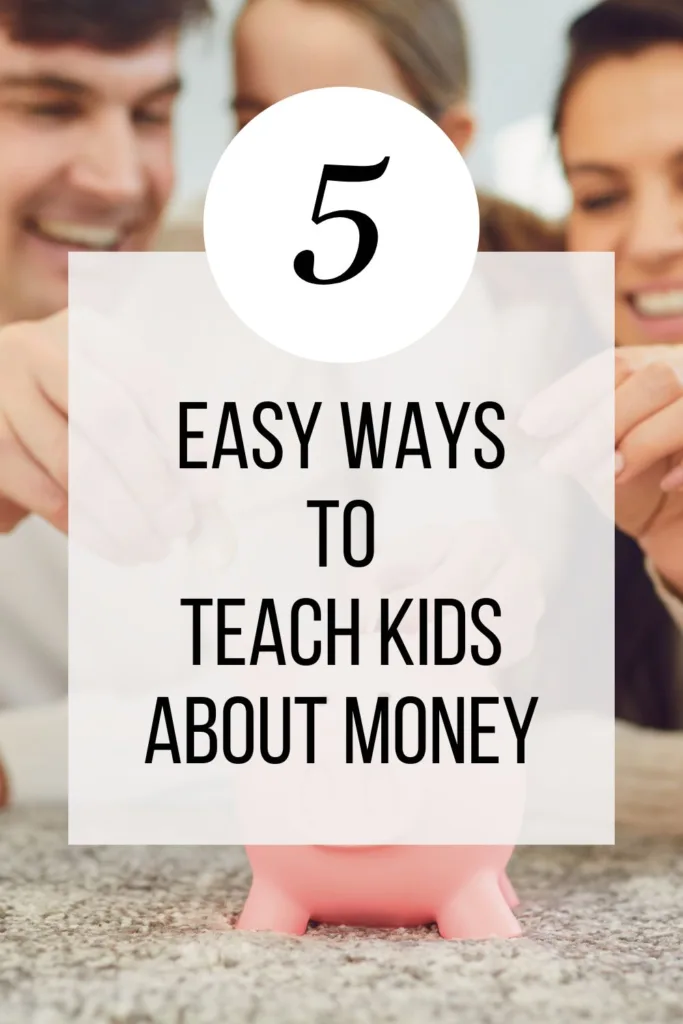Money is an important part of life, and it’s never too early to start teaching kids about it. In fact, the earlier you start, the better. Whether your child is 3 or 13, there are concepts to teach kids of all ages. Let’s dive into the 5 easy steps to teach kids about money:
Why Should You Teach Kids About Money?
According to a recent study by the National Financial Educators Council, only 38% of high school graduates have basic financial literacy skills. This means that most young adults are not prepared to manage their money effectively. Don’t depend on the school system or government to prepare your kids for the financial obstacles they will encounter. Help them learn the necessary skills needed to manage their money early on so they can be confident as teens and young adults.

Benefits of Teaching Kids About Money at a Young Age
As a mom, one of the most important skills I’m teaching my kids is financial literacy. Financial literacy is the ability to understand and manage money effectively, and it’s a skill that will benefit kids throughout their lives. Regardless of your income, you can prepare your kids for the future. This, to me, is so comforting to know because not everyone can afford to contribute huge sums to a college savings plan.
There are many benefits to teaching kids about money at a young age. Here are a few:
- It can help them develop good financial habits that will last a lifetime.
- It can help them avoid debt and financial problems in the future.
- It can give them a sense of control over their finances.
- It can help them make wise financial decisions.
- It can help them achieve their financial goals.
5 Steps to Teach Kids About Money
Step 1: Introduce the concept of money
One of the first things you can do to teach your kids about money is to introduce them to the different types of money. Show them the different coins, bills, and credit cards. Go ahead and pull out your wallet and let them see.
For younger children, explain the different types of coins, such as pennies, nickels, dimes, and quarters. Then describe bills that come in different denominations, such as $1, $5, $10, $20, and $50.
For older kids and teens, you can discuss how credit cards are used to buy things and that you pay off your credit later. Make sure they understand the importance of paying off credit card debt and credit scores.
Once your kids have a basic understanding of the different types of money, you can start to explain the value of money and how it can be used to buy things. Explain that money is a way to exchange goods and services. When you buy something, you are essentially trading your money for that item.
You can also help your kids understand the difference between needs and wants. Needs are things that we need to survive, such as food, shelter, and clothing. Wants are things that we would like to have, but we don’t need them to survive.

Step 2: Set up an allowance system
An allowance is a great way to teach kids about earning, saving, and spending money. It is a predetermined amount of money that you can give your children on a regular basis.
When setting up an allowance system, there are a few things to keep in mind:
- Decide whether to pay them for completing chores or a set amount each week, month, etc… You can do a combination of both where they receive a small amount allowance based, and then pay them a set amount for helping around the house.
BONUS: They get to learn the value of work! - Decide how much allowance to give your child. The amount of allowance you give your child will depend on your family’s income and your child’s age.
- Set clear expectations about how the allowance can be used. Let your child know that the allowance is for them to spend however they want, but that they should also be saving some of it.
- Be consistent. Pay your child their allowance on time and in the same way every time.
- Be flexible. If your child has a special need or want, you may want to adjust the amount of allowance they receive.
[RELATED] Allowance 101: The Ultimate Guide to Building Financially Savvy Kids with Allowances
An allowance can be a great way to teach your kids about money. It can help them learn how to earn, save, and spend money wisely. It can also help them develop good financial habits that will last a lifetime.
Step 3: Talk about saving
Saving money is an important financial skill that everyone should learn, and it’s never too early to start teaching kids about it. Here are a few tips for helping kids understand the importance of saving money:
Teach Them How to Set Savings Goals and How to Reach Them
Once kids understand the importance of saving money, you can start teaching them how to set savings goals and how to reach them. Here are a few tips:
- Help them choose a goal that is realistic and achievable. For example, they might want to save up for a new bike, a video game, or a trip to the amusement park.
- Break the goal down into smaller, more manageable steps. This will make it seem less daunting and more achievable.
Use my FREE Goal Planner to help them track their goals:
- Help them create a budget and track their progress. This will help them see how their savings are growing and stay motivated.
- Offer them rewards for reaching their goals. This will help them associate saving money with positive outcomes.
Encourage Them to Open a Savings Account
Once kids have a savings goal in mind, it’s time to open a savings account. This will give them a safe place to keep their money and help them track their progress. Here are a few tips for choosing a savings account for kids:
- Look for an account with low fees and no minimum balance requirements.
- Choose an account that offers interest on savings. This will help their money grow over time.
- Make sure the account is easy for kids to use. They should be able to deposit and withdraw money easily.
Step 4: Talk about spending
One of the most important financial skills that kids can learn is how to make wise spending decisions. This means being able to distinguish between impulse purchases and planned purchases, and being able to stick to a budget.
Here are a few tips for helping kids learn how to make wise spending decisions:
- Talk to them about the difference between impulse purchases and planned purchases. Impulse purchases are things that we buy on a whim, without thinking about them first. Planned purchases are things that we have thought about and decided that we want to buy. Help your kids understand the difference between these two types of purchases and why it’s important to make planned purchases more often than impulse purchases.
- Help them develop a budget. A budget is a plan for how you will spend your money. Help your kids create a budget that includes money for needs (things like food, clothing, and shelter) and wants (things like toys, games, and movies).
[RELATED] How to Create a Budget
Use my FREE Budget Blueprint printable to help show your child what a budget can look like:
- Be a good role model. Kids learn by watching the adults in their lives. If you want your kids to make wise spending decisions, you need to make wise spending decisions yourself. Don’t overspend on things that you don’t need.
Step 5: Talk about debt
Debt is something that most adults will have to deal with at some point in their lives. It can be a confusing and daunting concept for kids, but it’s important to start teaching them about it early.
Here is a simple way to explain debt to kids:
- Debt is money that you owe to someone else.
- When you borrow money, you have to pay it back, plus interest.
- Interest is the amount of money that you pay for the privilege of borrowing money.
- Debt can be used to buy things that you need or want, but it’s important to be careful about how much debt you take on.
[RELATED] How to Pay off Debt
There are two main types of debt: good debt and bad debt.
- Good debt is debt that you use to invest in something that will appreciate in value over time, such as a house or a college education.
- Bad debt is debt that you use to buy things that lose value over time, such as a car or a vacation.
It’s important to teach kids about the difference between good debt and bad debt so that they can make wise financial decisions when they are older. There are many financial “gurus” out there that villainize debt, but the reality is it can be a very useful tool. It can help build wealth when learned how to use it RESPONSIBLY.
[RELATED] How to Build Generational Wealth
Credit card debt = bad. Gambling debt = bad. Most other debt is good if you can find a reasonable interest rate. But that’s a topic for another blog post =)
Conclusion on How to Teach Kids About Money
In conclusion, money is an essential part of life, and it’s important for kids to learn about it at a young age. Financial literacy is a skill that will benefit kids throughout their lives, helping them make wise financial decisions and achieve their goals.
What ways have you taught your child about money?


